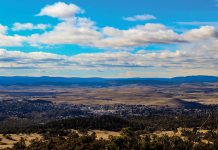This crew had to battle extremely bad weather including severe icing before making a safe landing.
I worked for a small regional airline that operated a 10-seat Piper Chieftain on a daily air transport service from country Victoria to Mascot, Sydney. When the aircraft was purchased, the oxygen system was removed to save weight and it was not equipped with a de-icing system.
At the time, I was teaching flying and conducting night theory classes, as well as managing the airline bookings and alternating as flight crew with the other line pilots. I thought I had a pretty good understanding of aviation meteorology and interpreting forecasts.
We operated the airline service with 2 crew members, which is not normally required for this size of operation, but I am certain that if we didn’t have 2 crew on this day, we would have had a disaster.
The captain – and pilot flying – on the first leg for the day, was a senior pilot with previous air transport experience in the tropics. Our destination, Sydney, provided us with narrow slot times for arrival and there was very little flexibility to adjust your departure times due to risky weather.
On the first leg, it was my job to compile the weather and NOTAMS, handle the passengers and operate the radios.
The weather briefings were sourced from AVFAX and it was a very clunky and slow system. I knew we had some serious weather forecast for our scheduled service that day. I heard news reports on the car radio that it was snowing in Yass and Goulburn and these locations were on our route.
The official forecast included a SIGMET for severe icing, heavy snow and freezing levels to the ground during our flight, which required plotting latitude and longitude on a chart to determine the extents of the SIGMET area.
The forecast covered a significant portion of our normal route, which was also over rugged high ground. Our aircraft was not equipped for flight into known icing and lacked propeller de-icing, wing de-ice boots and electrically heated windscreen.
I was very concerned about the forecast and quickly plotted an alternate route around the weather, with an approach to Sydney from the north. This alternate plan would take an extra 20 minutes to reach our destination.
I reviewed the enroute chart with the SIGMET area marked with highlighter, my alternate route plan and my weather assessment with the captain. He decided we would take our normal flight planned route and ‘have a look’ at the weather. The senior pilot had the authority and responsibility to make the important decisions.
The ice build-up continued, with the props now throwing ice onto the fuselage, creating loud bangs.
A chilling experience
The departure and flight proceeded as normal for the first hour and I nervously waited to see what the SIGMET area ahead had in store for us. As we approached the high ground, we were already cruising at our maximum permissible altitude of 10,000 feet.
As the terrain rose, so did the cloud tops and as soon as we entered cloud, we had rime ice forming. I was listening to another regional airline operating the same aircraft as us and heading to Sydney – they were requesting higher levels to clear the weather.
As the rime ice started to build up and became a concern, the captain announced he was descending to get out of the ice.
As we descended into the clouds, it became dark and the mixed ice rapidly built up. The lower level did not provide any respite from the rapid ice build-up, which was becoming very scary, with the leading edge showing a large double horn build-up – the HF aerial was about 30 mm in diameter and swinging like a skipping rope.
The indicated airspeed and our GPS ground speed were reducing and I was now worried about stalling due to the extra weight and drag. The captain descended further to our lowest enroute safe altitude but the ice build-up continued, with the props now throwing ice onto the fuselage, creating loud bangs.
The captain turned and headed towards Young. We were on a continual descent to try and maintain airspeed and I was counting down aloud the remaining miles to run to Young. We finally broke clear of the weather, extremely close to the airport and disturbingly low to the rocky terrain below.
We required a tight right-hand circling approach and the aircraft landed with a very heavy thump, well before we were expecting and probably stalled onto the ground.
We disembarked the aircraft and found some temporary comfort for the passengers. We spoke very little of what just happened but started planning an alternate route into Sydney.
We did not have enough fuel reserves remaining to head direct to Sydney and now needed to fly to another nearby airport to refuel first. Some of the passengers did not reboard at Young and made other travel arrangements and when we finally arrived in Sydney, some of the remaining passengers also decided not to return home with us.
I was happy to have survived the ordeal but knew we had lost valuable regular customers.
Lessons learnt
Looking back, it was a combination of factors that led to our near disaster. Our decision-making process was flawed and we were not properly equipped to handle the severe icing conditions we encountered. I learnt that everyone can make mistakes and it’s important to have a culture of open communication and cooperation in the cockpit.
After the incident, I submitted a detailed report to our safety officer and discussed the near accident with all the team. Looking back, I’m grateful for the experience. It taught me the importance of proper planning and decision-making, as well as the value of teamwork and communication in a high-stress situation. It also gave me a newfound appreciation for the power of nature and the need to always respect the weather.
Have you had a close call?
8 in 10 pilots say they learn best from other pilots and your narrow escape can be a valuable lesson.
We invite you to share your experience to help us improve aviation safety, whatever your role.
Find out more and share your close call here.
Disclaimer
Close calls are contributed by readers like you. They are someone’s account of a real-life experience. We publish close calls so others can learn positive lessons from their stories, and to stimulate discussion. We do our best to verify the information but cannot guarantee it is free of mistakes or errors.
Pilot safety hub
Weather and forecasting is one of the special topics on our Pilot safety hub.
Refresh your knowledge at the hub.





